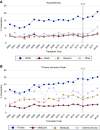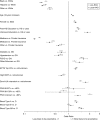Trends in Disparities in Preemptive Kidney Transplantation in the United States
- PMID: 31413065
- PMCID: PMC6777592
- DOI: 10.2215/CJN.03140319
Trends in Disparities in Preemptive Kidney Transplantation in the United States
Abstract
Background and objectives: Long wait times for deceased donor kidneys and low rates of preemptive wait-listing have limited preemptive transplantation in the United States. We aimed to assess trends in preemptive deceased donor transplantation with the introduction of the new Kidney Allocation System (KAS) in 2014 and identify whether key disparities in preemptive transplantation have changed.
Design, setting, participants, & measurements: We identified adult deceased donor kidney transplant recipients in the United States from 2000 to 2018 using the Scientific Registry of Transplant Recipients. Preemptive transplantation was defined as no dialysis before transplant. Associations between recipient, donor, transplant, and policy era characteristics and preemptive transplantation were calculated using logistic regression. To test for modification by KAS policy era, an interaction term between policy era and each characteristic of interest was introduced in bivariate and adjusted models.
Results: The proportion of preemptive transplants increased after implementation of KAS from 9.0% to 9.8%, with 1.10 (95% confidence interval [95% CI], 1.06 to 1.14) times higher odds of preemptive transplantation post-KAS compared with pre-KAS. Preemptive recipients were more likely to be white, older, female, more educated, hold private insurance, and have ESKD cause other than diabetes or hypertension. Policy era significantly modified the association between preemptive transplantation and race, age, insurance status, and Human Leukocyte Antigen zero-mismatch (interaction P<0.05). Medicare patients had a significantly lower odds of preemptive transplantation relative to private insurance holders (pre-KAS adjusted OR, [aOR] 0.26; [95% CI, 0.25 to 0.27], to 0.20 [95% CI, 0.18 to 0.22] post-KAS). Black and Hispanic patients experienced a similar phenomenon (aOR 0.48 [95% CI, 0.45 to 0.51] to 0.41 [95% CI, 0.37 to 0.45] and 0.43 [95% CI, 0.40 to 0.47] to 0.40 [95% CI, 0.36 to 0.46] respectively) compared with white patients.
Conclusions: Although the proportion of deceased donor kidney transplants performed preemptively increased slightly after KAS, disparities in preemptive kidney transplantation persisted after the 2014 KAS policy changes and were exacerbated for racial minorities and Medicare patients.
Keywords: European Continental Ancestry Group; HLA antigens; Hispanic Americans; Insurance Coverage; Medicare; Registries; United States; adult; allocation system; chronic kidney failure; deceased donor; diabetes mellitus; female; health policy; humans; hypertension; kidney failure, chronic; kidney transplantation; logistic models; preemptive kidney transplantation; renal dialysis; tissue donors; transplant recipients; unintended consequences.
Copyright © 2019 by the American Society of Nephrology.
Figures




Comment in
-
Persistent Disparities in Preemptive Kidney Transplantation.Clin J Am Soc Nephrol. 2019 Oct 7;14(10):1430-1431. doi: 10.2215/CJN.09800819. Epub 2019 Sep 26. Clin J Am Soc Nephrol. 2019. PMID: 31558484 Free PMC article. No abstract available.
References
-
- United States Renal Data System : Incidence, Prevalence, Patient Characteristics, and Treatment Modalities. 2017 USRDS Annual Data Report: Epidemiology of Kidney Disease in the United States, Chapter 1, Bethesda, MD, National Institutes of Health, National Institute of Diabetes and Digestive and Kidney Diseases, 2017
-
- Meier-Kriesche HU, Kaplan B: Waiting time on dialysis as the strongest modifiable risk factor for renal transplant outcomes: A paired donor kidney analysis. Transplantation 74: 1377–1381, 2002 - PubMed
-
- Cosio FG, Alamir A, Yim S, Pesavento TE, Falkenhain ME, Henry ML, Elkhammas EA, Davies EA, Bumgardner GL, Ferguson RM: Patient survival after renal transplantation: I. The impact of dialysis pre-transplant. Kidney Int 53: 767–772, 1998 - PubMed
-
- Kasiske BL, Snyder JJ, Matas AJ, Ellison MD, Gill JS, Kausz AT: Preemptive kidney transplantation: The advantage and the advantaged. J Am Soc Nephrol 13: 1358–1364, 2002 - PubMed
Publication types
MeSH terms
Grants and funding
LinkOut - more resources
Full Text Sources
Medical
Research Materials

